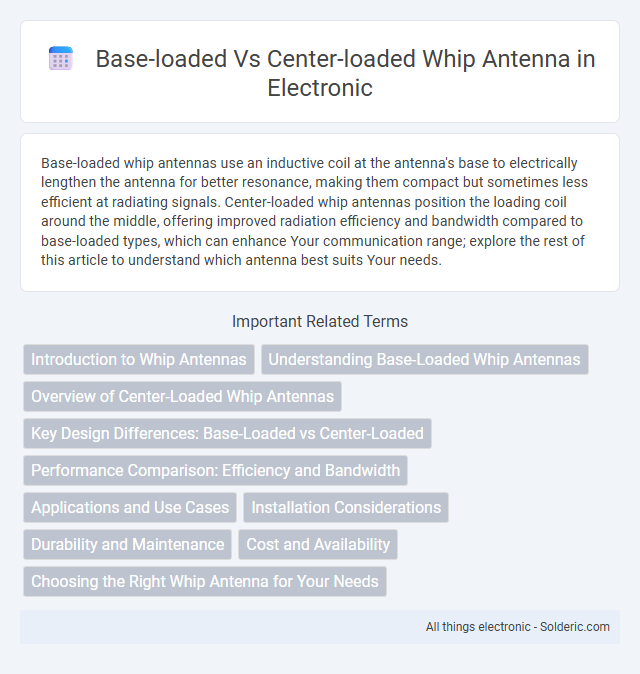Base-loaded whip antennas use an inductive coil at the antenna's base to electrically lengthen the antenna for better resonance, making them compact but sometimes less efficient at radiating signals. Center-loaded whip antennas position the loading coil around the middle, offering improved radiation efficiency and bandwidth compared to base-loaded types, which can enhance Your communication range; explore the rest of this article to understand which antenna best suits Your needs.
Comparison Table
| Feature | Base-Loaded Whip Antenna | Center-Loaded Whip Antenna |
|---|---|---|
| Loading Position | At the antenna base | Near the antenna center |
| Length | Shorter physical length using loading coil | Moderate length with coil at center |
| Radiation Efficiency | Lower efficiency due to ground proximity losses | Higher efficiency, better current distribution |
| Bandwidth | Narrower bandwidth | Wider bandwidth |
| Impedance | Lower feedpoint impedance (often 20-50 O) | Higher feedpoint impedance (typically 30-70 O) |
| Construction Complexity | Simple, easier to manufacture | More complex due to coil placement |
| Typical Applications | Mobile radios, handheld transceivers | Base stations, longer-range applications |
Introduction to Whip Antennas
Whip antennas are versatile, slim, and flexible radiators commonly used in mobile and portable radio communication. Base-loaded whip antennas incorporate a loading coil near the antenna's base to electrically lengthen the antenna, enhancing performance in constrained spaces. Center-loaded whip antennas position the loading coil midway along the element, balancing impedance and improving radiation efficiency, which can significantly impact Your signal quality and range.
Understanding Base-Loaded Whip Antennas
Base-loaded whip antennas use an inductive coil at the antenna's base to electrically lengthen the antenna, enabling efficient transmission and reception at lower frequencies despite their physically shorter length. This design improves resonance and impedance matching while maintaining a compact form factor ideal for mobile and portable applications. The coil's position at the base simplifies construction and durability but may introduce slight losses compared to center-loaded counterparts.
Overview of Center-Loaded Whip Antennas
Center-loaded whip antennas feature an inductive coil positioned at the midpoint of the antenna element, enhancing resonance and impedance matching for improved transmission efficiency. These antennas offer a balanced current distribution, reducing signal loss and providing better performance on compact vehicles or limited space installations. Your communication system benefits from the center-loaded design through increased bandwidth and more consistent radiation patterns compared to base-loaded alternatives.
Key Design Differences: Base-Loaded vs Center-Loaded
Base-loaded whip antennas incorporate an inductive coil at the antenna's base to electrically lengthen the antenna, making them more compact and easier to mount on vehicles or handheld devices. Center-loaded whip antennas feature a loading coil positioned near the middle, providing a more uniform current distribution, which enhances radiation efficiency and bandwidth. The key design difference lies in coil placement, influencing antenna size, tuning complexity, and overall performance in signal transmission and reception.
Performance Comparison: Efficiency and Bandwidth
Base-loaded whip antennas generally exhibit lower efficiency and narrower bandwidth due to increased losses in the loading coil and concentrated inductive reactance near the antenna base. Center-loaded whip antennas offer improved efficiency by distributing the loading coil along the antenna length, reducing resistive losses and achieving a more uniform current distribution. Bandwidth is typically broader in center-loaded designs, as the loading element's position enhances the antenna's resonant characteristics and reduces the Q factor compared to base-loaded counterparts.
Applications and Use Cases
Base-loaded whip antennas are commonly used in mobile communication devices and vehicles where limited space requires compact antenna designs, providing efficient signal transmission in urban and mobile environments. Center-loaded whip antennas are preferred in fixed installations and amateur radio setups for their improved bandwidth and tuning flexibility, making them ideal for stationary applications requiring optimized signal quality. Choosing your antenna depends on the specific use case, balancing size constraints with performance needs in various communication scenarios.
Installation Considerations
Base-loaded whip antennas require a sturdy grounding system or counterpoise for efficient performance, making installation more complex in locations without conductive surfaces. Center-loaded whip antennas are generally easier to install as they do not depend heavily on a ground plane, allowing more flexible mounting options such as non-metallic masts or fiberglass poles. Choosing between the two depends on available installation space and grounding capabilities, with center-loaded designs often favored for portable or rooftop setups where ground systems are limited.
Durability and Maintenance
Base-loaded whip antennas generally experience higher stress at the mounting point, which can lead to increased wear and the need for more frequent maintenance compared to center-loaded designs. Center-loaded whip antennas distribute mechanical stress more evenly along the antenna's length, enhancing durability and reducing the likelihood of damage from bending or impact. Choosing a center-loaded whip antenna can extend your antenna's lifespan and minimize maintenance efforts in demanding environments.
Cost and Availability
Base-loaded whip antennas are generally more affordable and widely available due to simpler design and common use in mobile and handheld radios. Center-loaded whip antennas often cost more because of their complex construction and specialized application, making them less prevalent in retail markets. Your choice depends on budget constraints and how easily you can source the antenna type for your specific frequency and device.
Choosing the Right Whip Antenna for Your Needs
Base-loaded whip antennas offer compact designs ideal for limited space and urban environments, providing effective low-frequency performance through an inductive loading coil at the base. Center-loaded whip antennas distribute the loading coil at the midpoint, enhancing efficiency and bandwidth for improved signal transmission and reception, making them suitable for mobile or portable communications. Selecting the right whip antenna depends on prioritizing factors such as space constraints, frequency range, and desired signal quality.
base-loaded vs center-loaded whip antenna Infographic

 solderic.com
solderic.com